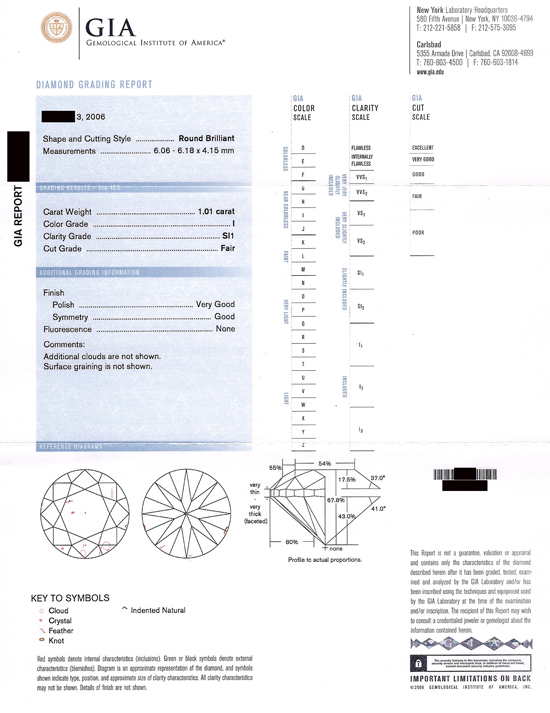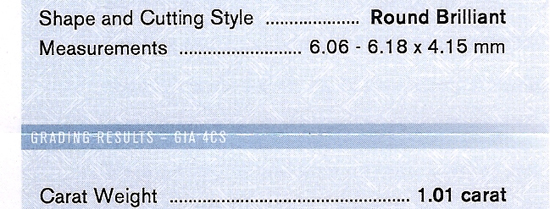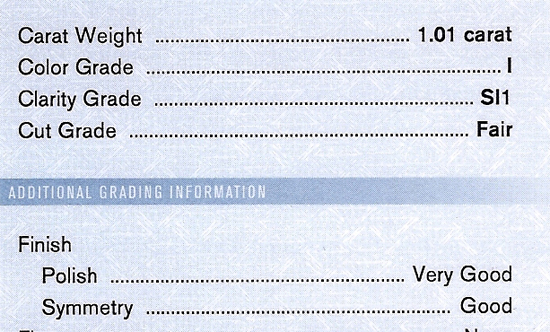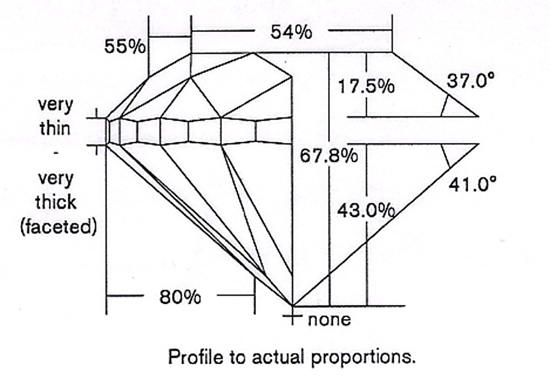What is a Built-Up Diamond?
January 22nd, 2011 by James L. Sweaney, CGA, FGA. GG
A Built Up Diamond
These days, we buy a lot of jewelry, used as well as new. Today, I worked with a young lady, a bit down on her luck and on the rebound from a relationship that didn’t work out. She was looking to sell her white gold solitaire ring that was set with the one carat round diamond graded on the cert above. After looking at her stone, I had to tell her that even though the stone had a GIA diamond grading report and the color and clarity were perfectly acceptable, I wasn’t interested in buying this particular diamond because of the poor cut.
This stone is what I call a “built-up” diamond, meaning that it weighs much more than it should for it’s apparent size. It’s important because although diamonds are sold for their beauty, they are always valued and priced by weight. In other words, this diamond looks like a diamond weighing only 9/10 of a carat but costs like a diamond over 1 carat. The consumer lost.
The clues to this problem are readily apparent on the GIA diamond grading report. To a gemologist, numerous measurements and grades show us immediately that this diamond is heavily cut. Let’s dissect the report to see what it really tells us.
First, the diameter, 6.06 – 6.18 is much too small for a well cut 1 carat round diamond. Ideal cut round diamonds weighing 1 carat always measure about 6.3 to 6.5 mm. in diameter.

Diameter vs. Weight
Next, moving down the report, we see the Cut Grade is Fair. Notice that the Finish grades are separate from the 4 C’s, Carat weight, Clarity, Color, and Cut. Although the Finish Grades, Polish and Symmetry are described as Very Good and Good and seem to indicate a well cut stone, the Cut Grade is much more important. Polish and Symmetry only describe the quality of the polish and the shape of the facets– they tell us little about the overall brilliance and light performance and the stone and nothing about excess weight the diamond carries.

The 4 C's
Three measurements shown in the profile diagram tell us exactly where the problem lies. Notice that the girdle of the diamond (the outer edge) is described as very thick. A normal girdle in a well cut stone would be in the slightly thin to slightly thick range and might carry 1 to 3 points of the total weight of a one carat diamond. A very thick girdle like this means this edge is much thicker than it needs to be. This “built up” girdle can add 7 to 10 points to a one carat diamond’s weight.
While the pavilion angles here are correct for a well cut diamond, the crown angle of 37 degrees indicates that the crown (top of the diamond) is much taller than it should be. Normal crown height should be about 14 to 15 % of the total depth– the report shows the crown height on this diamond is” built up” to 17.5%, again adding extra weight to the stone.
Last, the total depth percentage of this diamond is 67.8%. This very important number, which divides the total depth measurement by the average of the diameter measurements and is always expressed as a percentage, is a quick indicator of the cut of a round diamond. The preferred total depth percentage for well cut diamonds on today’s market ranges from about 60 to 62.5%, with some slight variance.

Proportions Tell the Tale
The issue here is that this couple bought inferior merchandise well disguised by a diamond grading report from GIA, the most well respected gemological lab in the world. As an asset of value, her diamond will have a very limited market because many jewelers like myself will pass on buying it because of the issues shown here.
Our advice is to shop wisely and not be fooled by outlandish promises like the double the value promises or by bargain prices. Don’t buy diamonds simply by price– in a luxury item, quality is the key ingredient.
Since an average person does not know how to read a grading report properly, the onus is on the seller to represent the goods fairly and honestly. While the grading report documents the quality of a diamond, the seller should interpret these facts for the consumer.
As members of the American Gem Society, our mission as gem merchants is to combine consumer education with fair and ethical business practices. Our professional gemologists and appraisers are always available to discuss and explain the essential facts about diamonds, gems and fine jewelery. We hope this blog was a step in that direction– give us your feedback!








January 27th, 2011 at 9:10 am
Excellent information! One question, in a case like this would it be possible to “fix” the diamond by re-cutting it or is the added expense just not worth it?
January 27th, 2011 at 11:51 am
Very good question, Brian! In some cases, you can “fix” the diamonds by recutting, but you have to do a cost vs. benefit analysis.
In this case, two factors dictate against recutting it. First, the weight of the diamond is only 1.01 cts, so the cutter has nothing to play with– by going below the one carat, the diamond is automatically devalued by 5-10%.
Second, the quality of this diamond is borderline for recutting– if the stone was VS and colorless, recutting could improve the beauty significantly, so the equation would be more beautiful vs less weight and more cost.
We often recut/repair damaged diamonds– even though diamonds are the hardest substance on the planet, like any gemstone, they are brittle, and can be chipped. Old European cut diamonds are especially prone to damage because in those days, the cutters usually made very thin girdles (outer edge of diamond).
It really takes an experienced gemologist to make this analysis, and even then, we usually consult and defer to our cutter’s opinion.